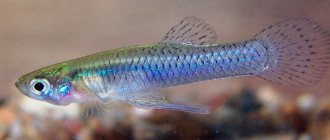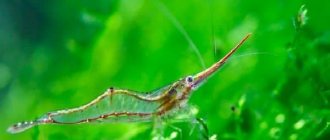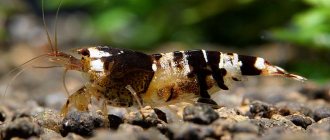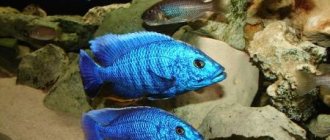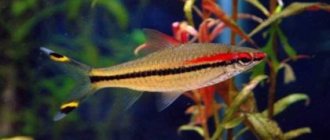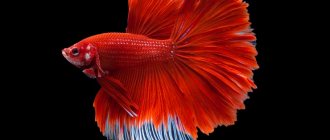The Elephantfish, also called the Nile Elephantfish and Peters Gnathonema, is an exotic fish with a distinctive appearance that is rarely found in home aquariums. A distinctive feature of its appearance is its long lower lip, used to search for food and contact with relatives. The character of representatives of the species is modest and timid, but when properly maintained, the pets are quite active. Elephants are extremely sensitive to the environment in the aquarium, light levels and the chemical composition of the water.
Description
A fish living in an aquarium rarely exceeds 15 cm in length, although when living in nature it can reach 25 cm. The description of its appearance is as follows:
- body – elongated, flattened;
- color – brown, almost black (in the light the scales have purple tints);
- the pelvic fins are absent, the pectoral fins are narrow and small, the anal and dorsal fins are located along the vertical axis close to the tail;
- the area of the body adjacent to the caudal fin is thin;
- the body between the dorsal and anal fins is decorated on both sides with light arched stripes;
- one of the main external characteristics is the lower lip, elongated, equipped with a large number of nerve fibers; it synthesizes minor electrical impulses necessary for orientation in space, searching for food, contact with relatives, and detection of enemies.
Breeding
In nature, fish reproduce easily and quickly. Partners reach puberty by 2-3 years. At the first spawning, the female lays up to 2000 eggs. After 2 weeks, offspring appear. From the first day, the fry is completely independent, obtains its own food and is able to hide from enemies.
In captivity, the Nile elephant does not reproduce at all. Scientists explain this by the fact that within an artificial reservoir, the electrical impulse is distorted and weakened, as a result of which the male cannot find his mate.
Even to this day, ichthyologists have not been able to distinguish between male and female individuals. It is assumed that this can be done by the strength of the electrical impulse produced by the fish, but there is no scientific confirmation of this fact.
This type of fish is imported from natural habitats, which is why they are so expensive and rare.
Habitat in nature
The range of the species belonging to the genus Mormirus (Elephantfish) covers the central and western regions of Africa (Niger, Cameroon, Congo, Chad, Zambia, Mali). The fish prefers rivers with weak currents, muddy water and an abundance of aquatic vegetation.
Gnathonemas live and feed in the benthic zone, obtaining food in the soil using a proboscis lip. Weak electrical discharges emitted by the proboscis help to search for food and communicate in muddy water. In nature, elephants eat insects and small soil invertebrates.
Features of reproduction
Elephant fish breed exclusively in natural conditions. For this reason, reproduction of these exotic aquatic pets in an aquarium environment is, unfortunately, impossible. The fact is that elephants use electrical impulses to mate and identify each other’s gender.
In an artificial environment, even under good conditions, their sensitivity indicators decrease, and they cannot identify a member of the opposite sex, which is the main obstacle to spawning.
Care and maintenance
Gnathonemus petersii is a gregarious species. The optimal number of individuals is 6 or 7. If the group is small, the fish feel uncomfortable and may become aggressive.
The aquarium requires a spacious one. The volume depends on the number of individuals, but should not be less than 100x45x45 cm. A container must be chosen with a lid, since elephants are able to jump out of the water.
Water parameters
Elephant fish are extremely sensitive to the amount of air, the chemical composition of water, especially the concentration of nitrates. Therefore, the owner needs to maintain stable water quality. And for this you need to install a good filter, but not one that creates the effect of a strong current, and an aeration system. Be sure to change 1/3 of the water every week, and treat the soil with a siphon, since most ammonia accumulates in the bottom area due to food debris and pet waste.
Optimal water parameters:
- temperature – from +24 to +28°C;
- hardness – from 5 to 15 units;
- acidity – about 7 pH.
Lighting
Since elephants are nocturnal fish that live in muddy water, the lighting should be dim.
Plants and decor
For elephant fish, it is advisable to equip the aquarium in such a way as to create an ecosystem close to natural habitat conditions. The aquarium should have a lot of plants and a variety of hiding places. It is advisable that there is at least one shelter for each individual: this will avoid aggressive division of the territory.
The soil you need to choose is soft, sandy. Coarse soil particles can damage the fish's trunk, causing it to be unable to feed and die from exhaustion.
Peters' elephant is sensitive to the presence of metals in water, so metal decorative elements should not be used in aquarium design.
Appearance
Elephant fish belongs to the Mormyrid family. Its homeland and habitat are African waters. These fish attract increased interest not only from aquarists, but also from scientists and zoologists due to their unusual appearance, feeding habits and physiological structure.
The elephant fish got its name not only because of the so-called trunk, but also because of its impressive size. The size of an adult fish in natural conditions is on average about 1.5 m, so such a pet can only be kept in large and spacious artificial reservoirs.
In general, the appearance of the elephant fish is very exotic and original. The body is shaped like a spindle, slightly flattened on the sides, and has a discreet dark brown color. Between the dorsal and anal fins there is a large black spot, covered with specific, fancy white stripes that create a contrast effect.
The lower lip of the animal is so strongly elongated that it forms a specific miniature trunk, which in fact is not one, intended not only for absorbing food, but also for obtaining it by tossing it in the water surface. The trunk is also used to process the soil, again in search of prey. But the real mouth is located slightly above the proboscis.
Elephant fish are predominantly nocturnal. During the day, they sleep in secluded corners at the bottom of the reservoir, and with the onset of dusk they begin to become active, getting food for themselves, or starting various games together with their brothers. Females and males are very similar to each other. You can only distinguish a female individual by carefully looking at her abdomen - it is slightly larger and rounder than that of males.
The elephant fish’s unique ability to emit weak electromagnetic pulses is necessary for them to orient themselves in space in a new place, as well as communicate with their relatives.
It should be noted that in aquarium conditions the size of the elephant fish is much smaller than in natural conditions, and is about 15 cm. In many ways, the length and volume of the fish depend on the conditions of detention and the size of the aquarium in which it grows.
Nile elephants lead a gregarious lifestyle and do not tolerate loneliness well, so an aquarist planning to have such an exotic pet needs to purchase at least a few individuals.
Feeding
The elephant is not capricious in its diet and willingly consumes live and dry food. It is best to give tubifex, bloodworms. The food can be varied with chopped meat and low-fat fish.
Elephant fish pick up food from the bottom and suck it in with their proboscis. They eat leisurely, so you should not keep gnathonemas and representatives of lively and active species that quickly grab food in a common aquarium. Otherwise, the elephants will remain hungry.
During the daytime, elephant fish are timid and shy, but at night (after turning off the lights) they become more active. Therefore, feeding separately from other species in the evening is recommended.
What to feed
In terms of nutrition, the elephant fish is quite picky; it can even be called an omnivore. For feeding, you can use both dry and frozen food. However, to maintain health and increase life expectancy, experts recommend enriching the diet with fortified and nutritious live food from time to time.
Elephants especially love bloodworms, daphnia, and tubifex worms.
It is best to feed the fish in small portions, since they absorb food only from the water surface, and it is important that the food is eaten immediately and does not sink to the bottom. Elephant fish have a tendency to overeat, so do not overfeed them. But at the same time, there should be enough food, since with a nutritional deficiency, serious conflicts and fights for food between aquarium inhabitants are possible.
Since representatives of this species are nocturnal, it is best to offer them food after dusk or at least by turning off the additional lighting. The most interesting quality that distinguishes the elephant fish from other inhabitants of the aquarium is its lack of fear of humans and good socialization. Having adapted to new conditions and getting used to its owners a little, the Nile elephant can eat food directly from their hands, which looks very cute and touching.
Compatibility
Elephant fish behavior is peaceful and sociable. They willingly get acquainted with new inhabitants of the aquarium, feeling them with their proboscis. They do not show aggression towards other species, both large and small.
But the elephants themselves can become a victim of attack by aggressors, so large, hostile species should not be placed in the aquarium.
Best compatibility with:
- catfish-shifters;
- scalars;
- Congo tetra;
- synodontis eupterus;
- Synodontis multispotted;
- butterfly fish.
Personality traits and behavior in the aquarium
The elephant fish is distinguished by its peace-loving, calm, friendly and even somewhat phlegmatic temperament. Representatives of this species almost never show aggression towards their relatives or other aquarium inhabitants, with the exception of prolonged lack of food.
They begin to be active at night, and spend most of their time resting at the bottom of the aquarium or calmly swimming in the lower layers of the water. Despite its impressive size, the elephant fish poses absolutely no danger to small fish, mollusks, and snails. But proximity to other large, but at the same time predatory and aggressive fish should be avoided. Catfish, butterfly fish, Congo fish, and Synodontis cuckoo will be excellent neighbors for the Nile elephant.
Keeping in mind that these fish lead a schooling lifestyle, experts advise keeping at least 5 individuals at once.
The fact is that if only two representatives of this species live in an aquarium, then, as a rule, rivalry, competition, and a struggle for leadership and territory begin between them.
Diseases and prevention
How long elephants live depends on the quality of water and care. But the average life expectancy in aquarium conditions is 8 – 10 years.
Due to improper maintenance, fish can contract infectious diseases. Treatment is complicated by the fact that representatives of the species are extremely susceptible to the negative effects of antibiotics.
Preventing infections involves maintaining the balance of the aquarium ecosystem. It is necessary to maintain water quality and feed pets properly and fully.
The Nile elephant is an exotic pet that can decorate any aquarium. The main condition for a long and healthy life of a fish is simple but competent care.
Interesting Facts
Every rare species is surrounded by many myths. Peters's gnathonemas are no exception; they belong to a rare family of river inhabitants, and therefore have been little studied. They are difficult to catch with nets or fishing rods due to their ability to electrolocate, which helps the fish detect the movement of a falling grain of sand.
Facts about Ubangi:
- It is interesting that Arabs have a superstitious fear of this fish. They believe that she sees with her tail.
- Americans and Germans purchase Nile elephants to test water quality.
- If you compare the brains of a person and a given type of fish, it turns out that they are equal in size.
LEAF FISH: DESCRIPTION, CARE AND MAINTENANCE IN THE AQUARIUM, PHOTO, REPRODUCTION
MUD JUMPER: DESCRIPTION, CARE AND MAINTENANCE IN THE AQUARIUM, PHOTO
SPRAY FISH: DESCRIPTION, CONTENTS, BREEDING, PHOTO, VIDEO
How to choose a fish
Before being sold, ubangs travel a long way from Africa. Not every individual can painlessly endure such a difficult journey and acclimatization in an aquarium. The main goal of the aquarist in this case is to get a healthy, well-adapted specimen.
How to correctly identify a healthy fish:
- During transportation, injuries cannot be avoided. Gnathonemas should be free of scratches, wounds and ruffled scales, with long, intact proboscis and clear eyes. Plucked fins are restored within a few weeks.
- Nutrition is the main indicator of health. If the fish is sick, poisoned or depressed, then it refuses food. Healthy individuals are well-fed and actively select food.
- Observe a school of fish, choose their leader - the largest and most active individual, capable of gathering a school and instilling confidence in its relatives. It is these specimens that best adapt to new environmental conditions.
- Do not buy fish from freshly imported batches. The first month is the most difficult; it is during this month that acclimatization and culling of unadapted individuals occurs.
Nutrition
In an aquarium they are quite unpretentious and will accept frozen, live and dried food. They prefer bloodworms and tubifex.
Sometimes you can diversify the menu with small pieces of meat or lean fish. It collects food at the bottom, first throws food up, and then sucks it up.
The fish is quite slow and cannot compete with its more active neighbors in the fight for food, so it is important to ensure that they receive enough food.
Features and habitat of elephant fish
Who doesn’t swim in the depths of the sea! These include sawfish, needlefish, moonfish, cockerel fish, and even elephant fish. True, the elephant fish is considered more likely to inhabit aquariums than the depths of the sea; it is too interesting.
It is worth saying that you will not see such an interesting fish in every home aquarium. And all because it is too rare. And it requires care that not every novice aquarist can afford. After all, it is so sensitive to the composition of water that it is even specially used in the USA and Germany in order to check the quality of water.
But if such a guest settles in the aquarium, then watching him will be a real pleasure. The elephant fish (or Nile elephant) got its name because it has a trunk. Of course, this is not a real trunk, it is the lower lip of the fish that is so modified that it resembles the trunk of an elephant. This is what sets it apart from other fish.
The size of the Nile elephant reaches 22-25 cm. But in captivity they do not reach such sizes. In an aquarium, they can grow only up to 15 cm. The body shape is elongated, dark gray in color with light stripes, which are located closer to the tail. The Nile elephant itself is shy and rather modest in behavior, however, if excellent conditions are created for it, it will be able to show itself in all its glory.
No matter how modest the aquarium elephant , this unusual fish is not so simple. For example, she can emit weak electric fields. She uses them not for attack or defense at all, but to find food or detect partners. It is also very interesting that this fish is literally a “professor” among its fellow fish, because scientists claim that its brain is as large in proportion to its body as the human brain.
In nature, such a fish can only be seen in the reservoirs of Nigeria, Congo, Zambia, Cameroon, Chad, and Benin. That is, the elephant fish , like ordinary elephants, lives only in warm areas. They stay close to the bottom, where there is soft soil, and get food there.
